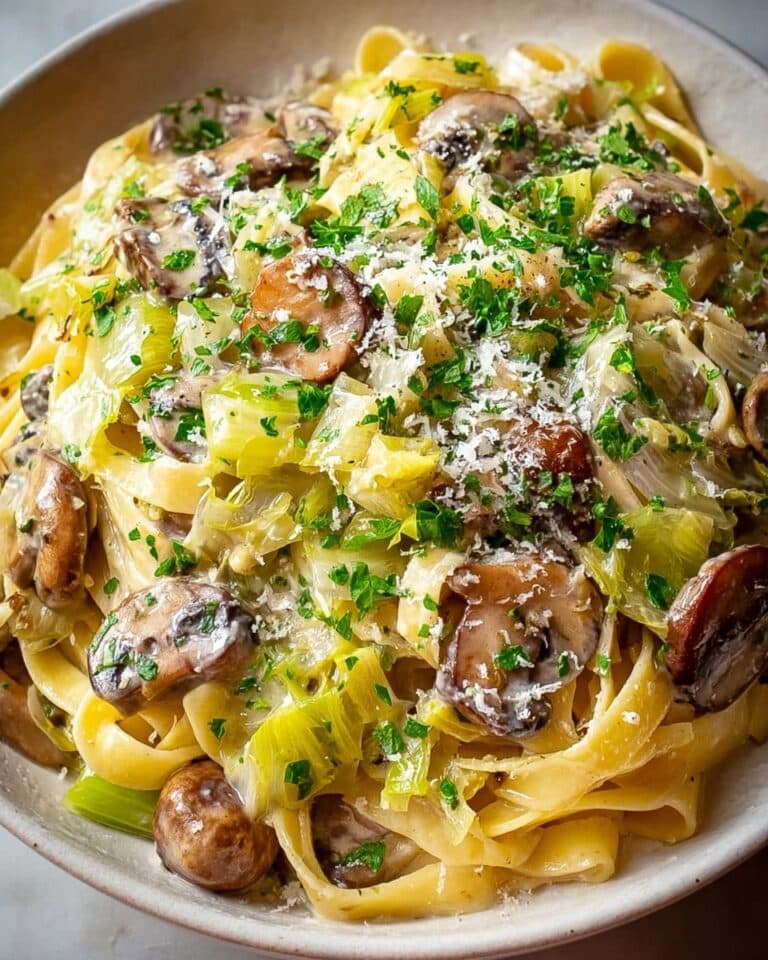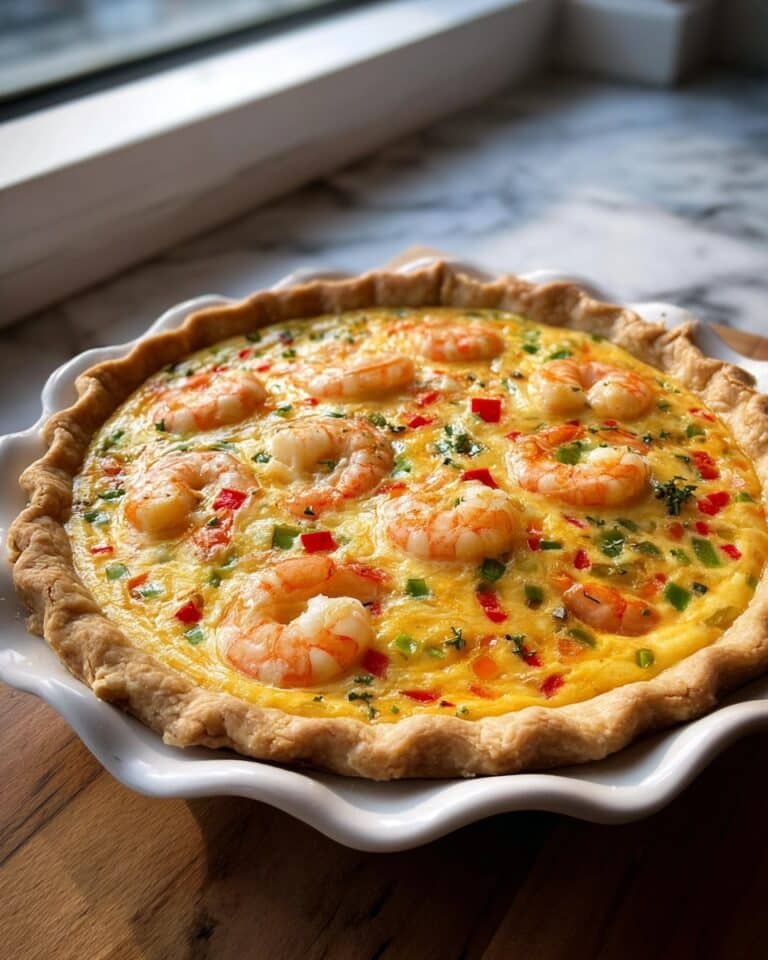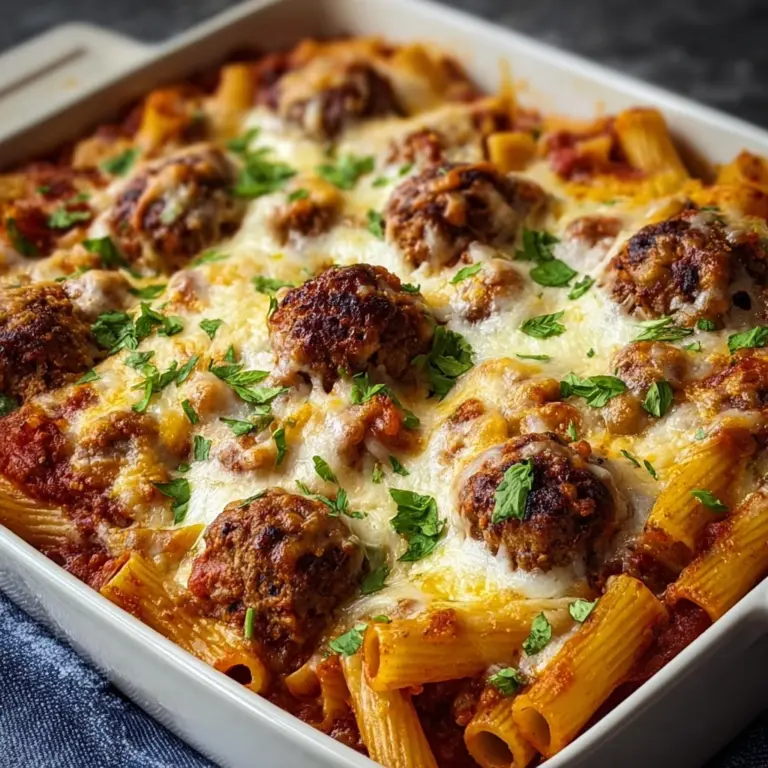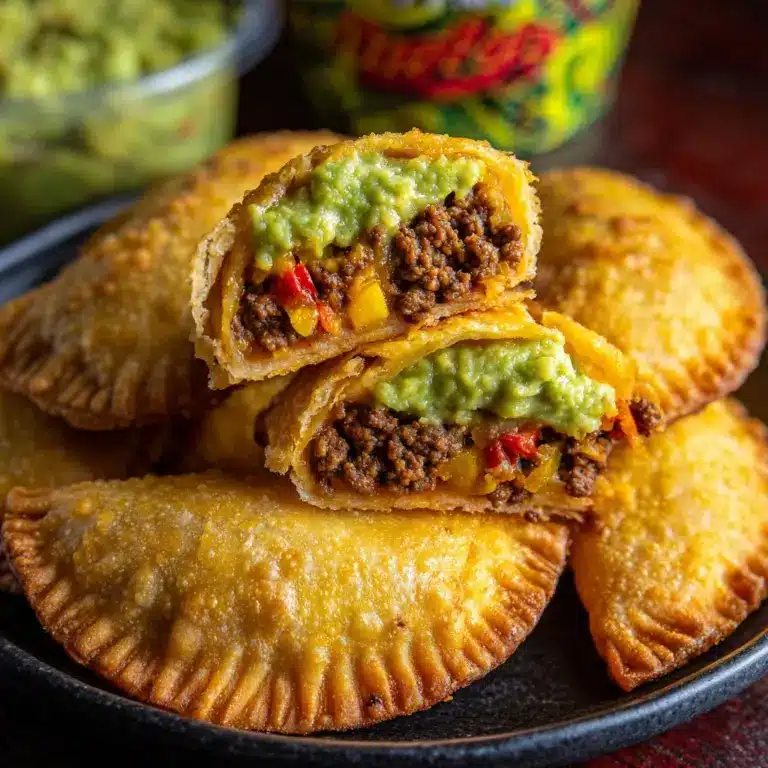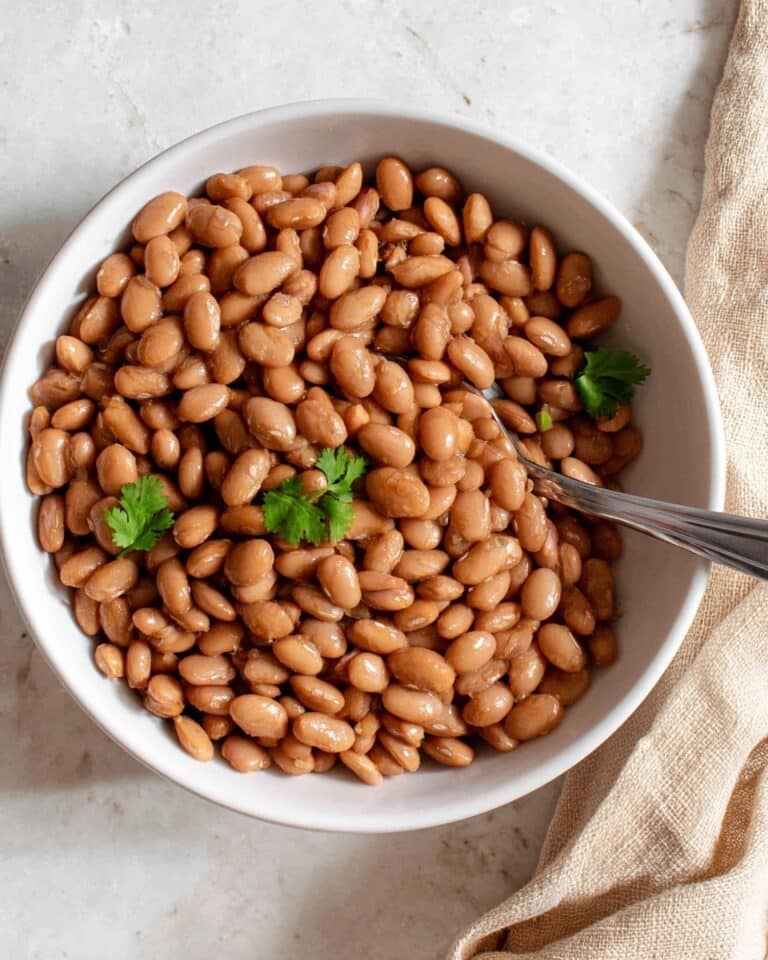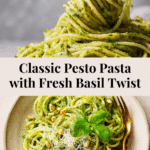Pesto Pasta Recipe
Pesto Pasta is the kind of meal that never lets you down: fragrant basil, creamy Parmesan, crunchy pine nuts, and silky olive oil come together to cloak perfectly cooked spaghetti in a vibrant green embrace. It’s the ultimate quick comfort food, bursting with freshness and bold Italian flavors in every bite. Whether you’re whipping up a speedy weeknight dinner or treating friends to a homemade masterpiece, this classic dish will steal the spotlight—and quite possibly your heart.
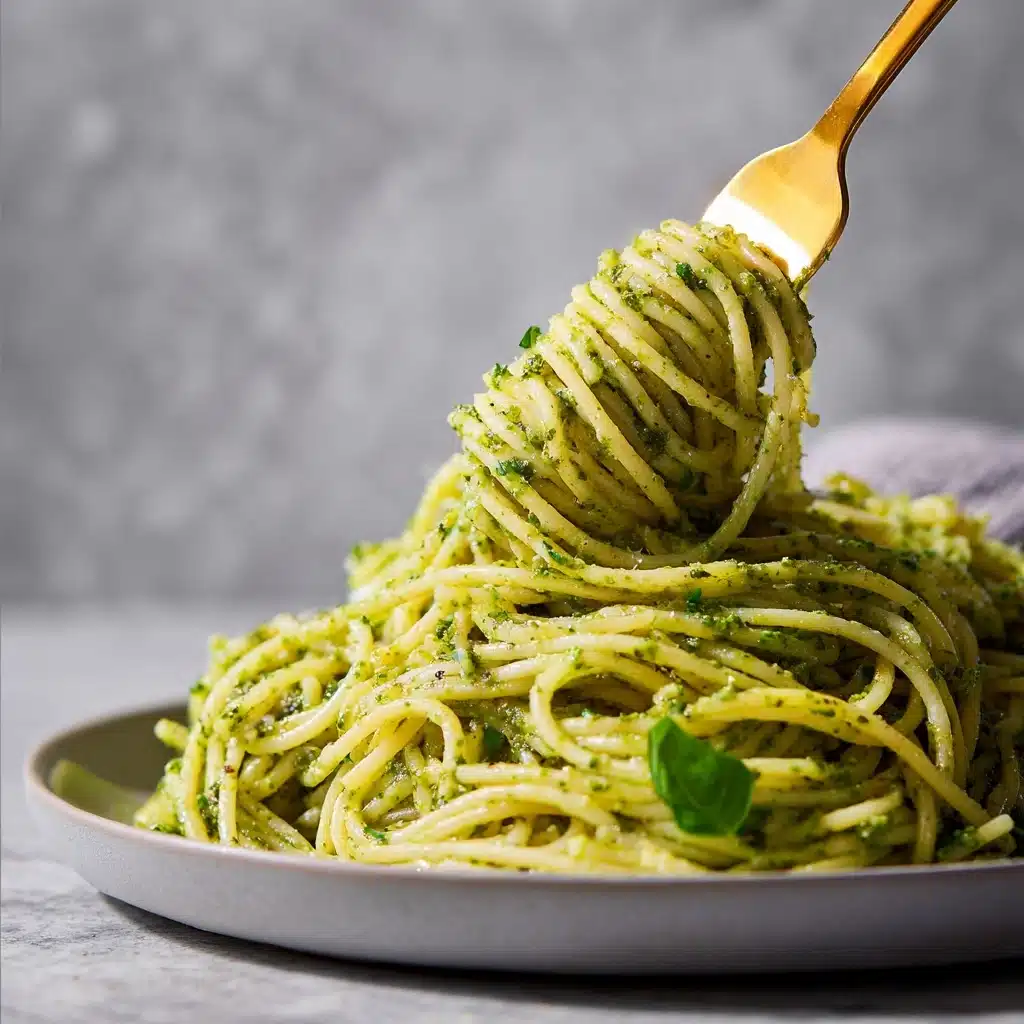
Ingredients You’ll Need
This dish shines because of its simplicity, relying on top-quality, fresh ingredients to work their magic together. Every element plays a role in crafting the signature texture, flavor, and color of Pesto Pasta, from the bright basil to the rich cheese.
- Spaghetti (400 g dried): Go for a sturdy pasta shape, because its texture soaks up every drop of vibrant pesto.
- Fresh basil leaves (50 g): This is the soul of the dish—choose leaves that are bright, fragrant, and unblemished for the best flavor and color.
- Garlic (2 cloves, peeled): Adds irresistible depth and a subtle zing that wakes up the basil and cheese.
- Pine nuts (40 g): These creamy, buttery nuts give pesto its signature rich flavor, and toasting them amps up their nuttiness.
- Freshly grated Parmesan cheese (30 g + 2 tbsp for serving): For the creamiest texture and sharp, salty punch, always grate from a wedge right before using.
- Freshly ground black pepper (½ tsp + for serving): A crack or two of pepper adds gentle heat and complexity.
- Maldon salt (½ tsp): These salt flakes dissolve beautifully, bringing out the basil and cheese flavors spectacularly.
- Olive oil (90 ml): Use a good-quality, fruity extra virgin olive oil to create a silky, aromatic pesto sauce.
- Toasted pine nuts (2 tbsp, for garnish): Adds an extra layer of crunch and nutty aroma on top.
- Fresh baby basil leaves (1 handful, for garnish): A scatter of fragrant leaves boosts aroma and gives your finished dish visual flair.
How to Make Pesto Pasta
Step 1: Cook the Spaghetti
Bring a large pot of salted water to a rolling boil, and drop in your dried spaghetti. Let it bubble away for 10-13 minutes, stirring occasionally to prevent sticking, until it’s al dente or done to your liking. Remember, pasta continues cooking a bit off the heat, so taste a strand a minute or two before you think it’s ready.
Step 2: Make the Pesto
While the pasta cooks, it’s time for the star of the show: the pesto. In a food processor, add the fresh basil leaves, peeled garlic, pine nuts, grated Parmesan, black pepper, and Maldon salt. Pulse everything together for about 10 seconds, just enough to break up the nuts and garlic and start building a rough mixture.
Step 3: Blend and Stream in Olive Oil
Switch the processor back on and slowly drizzle in the olive oil in a steady stream, letting the whole mixture emulsify into a luscious, green sauce. If you like a rustic, chunky texture, it’s ready to go after about 10 seconds. Want it silkier? Just whizz it a bit longer, up to 20 seconds more, until you hit your pesto sweet spot. Taste and adjust for salt, then set the pesto aside.
Step 4: Drain the Pasta and Reserve Water
Once your spaghetti is perfectly cooked, reserve about a cup of the starchy pasta water before draining. This water is liquid gold—it helps the pesto cling to the pasta and creates a glossy, restaurant-worthy finish.
Step 5: Toss Spaghetti with Pesto
Return the drained spaghetti to the warm pan (off the heat) and add in all your pesto plus about a third of a cup of the reserved pasta water. Use tongs to toss everything together over low heat for a minute or two. The sauce will coat each strand with fragrant, creamy goodness. Add a splash more water if you prefer your Pesto Pasta a little looser.
Step 6: Plate and Finish
Twirl your Pesto Pasta onto plates or bowls and shower with the reserved Parmesan, toasted pine nuts, basil leaves, and a crack of black pepper. These last hits of flavor and color make every serving irresistible.
How to Serve Pesto Pasta
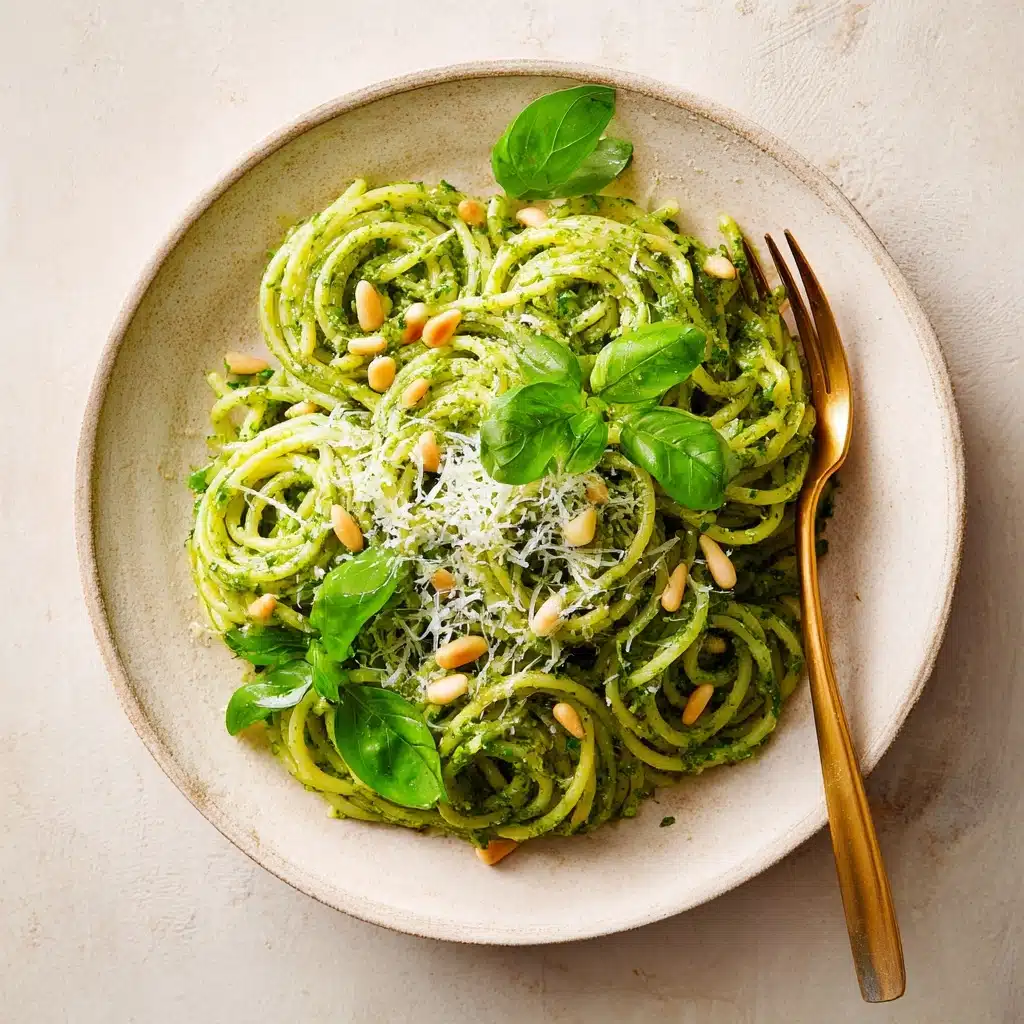
Garnishes
The right garnishes elevate the look and flavor of your Pesto Pasta from simple to stunning. Try topping with extra grated Parmesan, a few toasted pine nuts for crunch, and generous baby basil leaves for a fresh burst. A grind of black pepper over the top is the final touch, adding both aroma and a little color contrast.
Side Dishes
Pesto Pasta is delightfully satisfying on its own, but even better alongside a crisp green salad tossed with lemony vinaigrette, or some juicy cherry tomatoes with a splash of balsamic. For heartier appetites, serve up some garlic bread or a side of roasted veggies—zucchini, asparagus, or bell peppers work wonderfully.
Creative Ways to Present
If you’d like to impress guests or just jazz up your weeknight, you can nestle your Pesto Pasta in a wide shallow bowl and spiral it tall with tongs for restaurant-style presentation. Swirl in extra pesto for rich green marbling, or try serving it as a cold pasta salad, stirred with mini mozzarella balls and sundried tomatoes for a picnic-ready twist.
Make Ahead and Storage
Storing Leftovers
If you find yourself with extra Pesto Pasta, let it cool completely before transferring to an airtight container. It will keep happily in the fridge for up to three days without sacrificing too much freshness or flavor.
Freezing
To freeze, hold off on mixing your pasta and pesto. Spoon the pesto into a small, airtight jar or freezer bag and freeze for up to three months. When you’re ready for Pesto Pasta, simply thaw the pesto overnight in the fridge and toss with freshly cooked spaghetti.
Reheating
To gently reheat leftovers, pop the pasta in a skillet with a splash of water over low heat, stirring and tossing until warmed through. Avoid microwaving for long periods, as this can make the basil lose its fresh flavor and turn the pasta mushy.
FAQs
Can I use a different pasta shape for Pesto Pasta?
Absolutely! While spaghetti is traditional, feel free to try linguine, fusilli, penne, or even orecchiette—the pesto clings beautifully to all sorts of shapes, so use what you love or have on hand.
What can I use if I don’t have pine nuts?
If pine nuts are hard to find (or a bit pricey), swap in walnuts, cashews, or even sunflower seeds. Each brings a slightly different but delicious twist to classic Pesto Pasta.
Can I make it vegan?
Yes! Just replace the Parmesan with a plant-based hard cheese or a spoonful of nutritional yeast for that unmistakable savoriness, and double-check your pasta is egg-free.
Why does my pesto turn brown?
Fresh basil can darken quickly when exposed to heat or air. Using very fresh leaves, pulsing briefly, and storing pesto with a thin layer of olive oil on top all help preserve that bright green color in your Pesto Pasta.
Is it possible to prepare the pesto by hand?
Traditionally, pesto is made with a mortar and pestle for a chunkier, more rustic texture and a bit more aromatic depth. It takes a little elbow grease, but many pesto purists swear by the results.
Final Thoughts
From weeknight dinners to gathering around the table with friends, Pesto Pasta is pure joy in a bowl—bursting with emerald color, rich flavors, and a comforting simplicity that never gets old. Give it a try, and you just might have a new favorite on your hands.
PrintPesto Pasta Recipe
This Pesto Pasta recipe is a classic and flavorful dish that is easy to make at home. Fresh basil, garlic, pine nuts, and Parmesan cheese come together to create a vibrant and aromatic pesto sauce that coats the perfectly cooked spaghetti. Topped with additional Parmesan, pine nuts, and fresh basil leaves, this dish is sure to impress your family and friends.
- Prep Time: 15 minutes
- Cook Time: 15 minutes
- Total Time: 30 minutes
- Yield: 4 servings 1x
- Category: Main Course
- Method: Cooking
- Cuisine: Italian
- Diet: Vegetarian
Ingredients
For the Pesto:
- 50 g (1.75 oz) fresh basil leaves ((approximately two packed cups))
- 2 cloves garlic, peeled
- 40 g (3 tbsp) pine nuts
- 30 g (1/3 cup) freshly grated Parmesan cheese
- 1/4 tsp freshly ground black pepper
- 1/2 tsp Maldon salt
- 90 ml (1/3 cup) olive oil
For the Pasta:
- 400 g (14 oz) dried spaghetti
- 2 tbsp freshly grated Parmesan cheese
- 2 tbsp toasted pine nuts
- 1 handful of fresh baby basil leaves
Instructions
- Cook the Spaghetti: Add the dried spaghetti to a large pan of salted boiling water and cook for 10-13 minutes until al dente.
- Make the Pesto: In a food processor, combine basil, garlic, pine nuts, Parmesan, black pepper, and salt. Pulse, then slowly add olive oil until smooth.
- Combine Pasta and Pesto: Toss drained spaghetti with pesto and a splash of pasta water over low heat until well coated.
- Serve: Divide into bowls, garnish with black pepper, Parmesan, pine nuts, and basil leaves.
Notes
- For a creamier pesto, add a bit of heavy cream or cream cheese.
- Adjust the consistency of the sauce with reserved pasta water.
Nutrition
- Serving Size: 1 serving
- Calories: 480 kcal
- Sugar: 2g
- Sodium: 380mg
- Fat: 21g
- Saturated Fat: 4g
- Unsaturated Fat: 15g
- Trans Fat: 0g
- Carbohydrates: 63g
- Fiber: 4g
- Protein: 14g
- Cholesterol: 6mg
Keywords: Pesto Pasta, Pasta Recipe, Basil Pesto, Italian Pasta, Easy Pasta Dish


